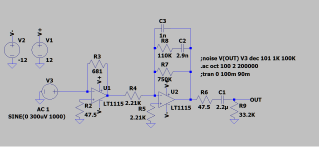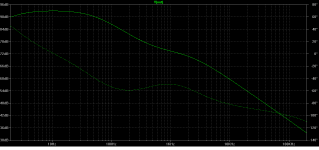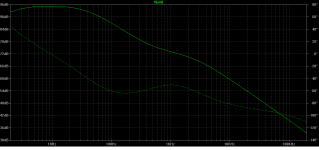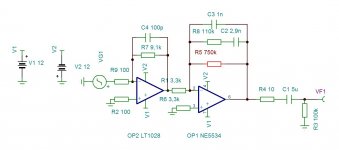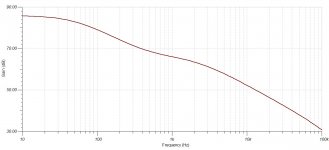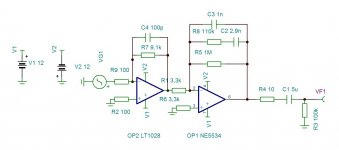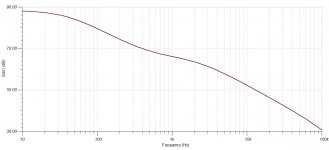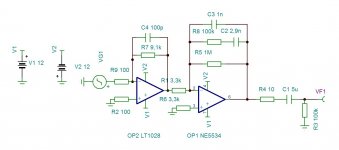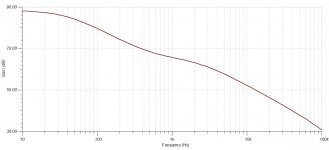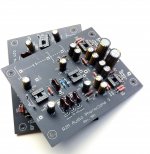Aside from output coupling/blocking DC (if there is any on the opamp output, which I don't see happening - but opamps are a bit of a black hole to me...), what is the role of the output cap on the VSPS? Can the value be changed? It seems like it would provide a high pass with R7 and the input impedance of the next stage, but if that's so, there would seem to be wide flexibility on values before there were any impact to audible frequencies. Do I have it right, or are there other issues with changing that cap?
Thanks!
Thanks!
Again a little discussion about RIAA..
Phonoclone spice model.. are we really going back there again?
Two versions of the RIAA network .. which one do you think is more accurate?
I have a bad feeling about this... I was really hoping we wouldn't have to go there again.
Alright then. I see one circuit and two identical frequency response curves. What gives?
First though, I'd like to preface the discussion with two declarations -
1. At the end of the day it doesn't matter how accurate the RIAA response is. As long as it is not terrible. The very slight deviations may be audible as a subtle change in sonic character, but in the context of the audio playback chain a perfectly accurate equalization curve is not necessarily any better sounding than a slightly less perfect one.
2. The is no need to ask whether curve A is more accurate than curve B. The matter can easily be settled quantitatively by comparing both data sets to the published RIAA response. (here for example) Examine the difference curve, it will tell you all you need to know.
Richard
p.s. phono stage response should always be presented as the difference data (Device response - RIAA response). It's simply impossible to make any useful assessment looking at the device response alone.
Last edited:
1. At the end of the day it doesn't matter how accurate the RIAA response is. As long as it is not terrible. The very slight deviations may be audible as a subtle change in sonic character, but in the context of the audio playback chain a perfectly accurate equalization curve is not necessarily any better sounding than a slightly less perfect one.
2. The is no need to ask whether curve A is more accurate than curve B. The matter can easily be settled quantitatively by comparing both data sets to the published RIAA response. (here for example) Examine the difference curve, it will tell you all you need to know.
Richard
p.s. phono stage response should always be presented as the difference data (Device response - RIAA response). It's simply impossible to make any useful assessment looking at the device response alone.
You're saying that the curve A is genuine.. I do not agree with that but forget it..
Now I can not decide between B and C.. I will finally put a 105k resistor..
Attachments
You're saying that the curve A is genuine.. I do not agree with that but forget it..
I really fail to see where you got to the conclusion of Richard saying that he thinks A is genuine.
On the other hand, just to clarify things, I think the graphs you have posted are worthless, for the simple reason that they don;t show the ideal RIAA response superimposed on the simulated response.
Without both graphs, one cannot tell how far off the deviation is.
But anyway, I'll blame it on language barrier eventhough your previous posts make it doubtful.
Regards
Nick
A few VSPS questions
Hi Richard,
Received the board yesterday and it's quite nicely made. Thanks. Time to get soldering, but for the breadboard I used what I had on hand and want to think about places to spend a little extra for new parts. But I have a few questions.
I don't see much about specific PS part numbers in the construction guide so I'm a little confused about C8 and C9. You mention bypass caps for the big filter caps, but these would seemingly only apply to C6 and C7 (filter caps after the 7*12 regulators). Is that what's intended (i.e. no bypass caps for the 1000uF filter caps C4 and C5)? And I assume these should be in the vicinity of 0.1uF (1/100th of the cap they are bypassing)?
Also, the link to the parts list (which might have helped with that question) appears to be dead.
Lastly, I am trying to decide what to use for the RIAA caps (the mica ones I found are quite pricey) and was considering film instead. What do you think? I used ceramics in the breadboard and the results were pretty good.
OK thanks!
Hi Richard,
Received the board yesterday and it's quite nicely made. Thanks. Time to get soldering, but for the breadboard I used what I had on hand and want to think about places to spend a little extra for new parts. But I have a few questions.
I don't see much about specific PS part numbers in the construction guide so I'm a little confused about C8 and C9. You mention bypass caps for the big filter caps, but these would seemingly only apply to C6 and C7 (filter caps after the 7*12 regulators). Is that what's intended (i.e. no bypass caps for the 1000uF filter caps C4 and C5)? And I assume these should be in the vicinity of 0.1uF (1/100th of the cap they are bypassing)?
Also, the link to the parts list (which might have helped with that question) appears to be dead.
Lastly, I am trying to decide what to use for the RIAA caps (the mica ones I found are quite pricey) and was considering film instead. What do you think? I used ceramics in the breadboard and the results were pretty good.
OK thanks!
Oops, I the link text in my post above was corrupted for some reason. The url is http://phonoclone.com/pcb.html.
For some strange reason, people on OSX seem to have more trouble reading the zip archives than those using Windows.
For some strange reason, people on OSX seem to have more trouble reading the zip archives than those using Windows.
Great, thank you, that worked. And no trouble un-zipping and opening the file in LibreOffice on OSX.
I had forgotten the BOM link on that page. The link that wasn't working is on the Construction Guide page, under Sourcing the parts. The link is: (http://phonoclone.com/files/pcb-bom.zip).
I had forgotten the BOM link on that page. The link that wasn't working is on the Construction Guide page, under Sourcing the parts. The link is: (http://phonoclone.com/files/pcb-bom.zip).
The high gain of the phonoclone means the output offset voltage is quite high, perhaps as much as 1 V, so it is not really a good idea to remove the output coupling caps. You can replace it with a DC servo, with a daughter-board for the extra components.
Or you can learn to live with whatever small color creeps in as a result of the capacitor, and use one which you happen to like most.
Hey Richard,
I just ordered one of your VSPS 300 kits
Is it possible to replace the output capacitor of the VSPS with the servo output section of the Kevin Gilmore headphone amp (A Pure Class A Dynamic Headphone Amplifier | HeadWize)? Any tips for how to do this?
Just about to start soldering my VSPS board and I was wondering what are the most important resistors from a sound standpoint (i.e. which ones are worth spending extra on resistors)? I've read that the load resistor (47k) in many phono stages is a good one to spend $$ on and I happen to have a pair of nude foil 47k resistors on hand (along with some 1k). I was thinking I'd install some sockets for any resistors worth rolling, hence my question.
Thanks!
Thanks!
- Home
- Source & Line
- Analogue Source
- The Phonoclone and VSPS PCB Help Desk
